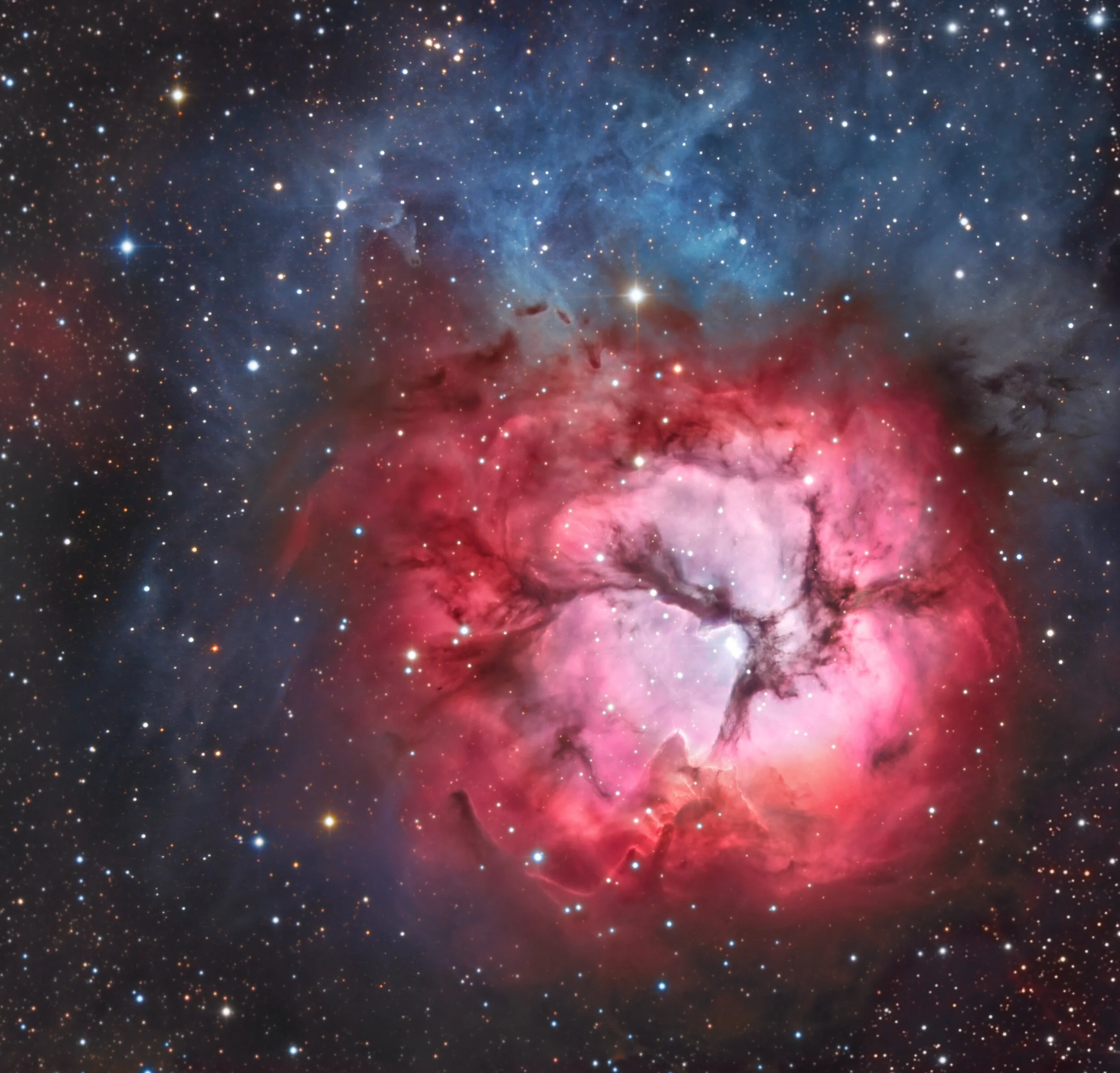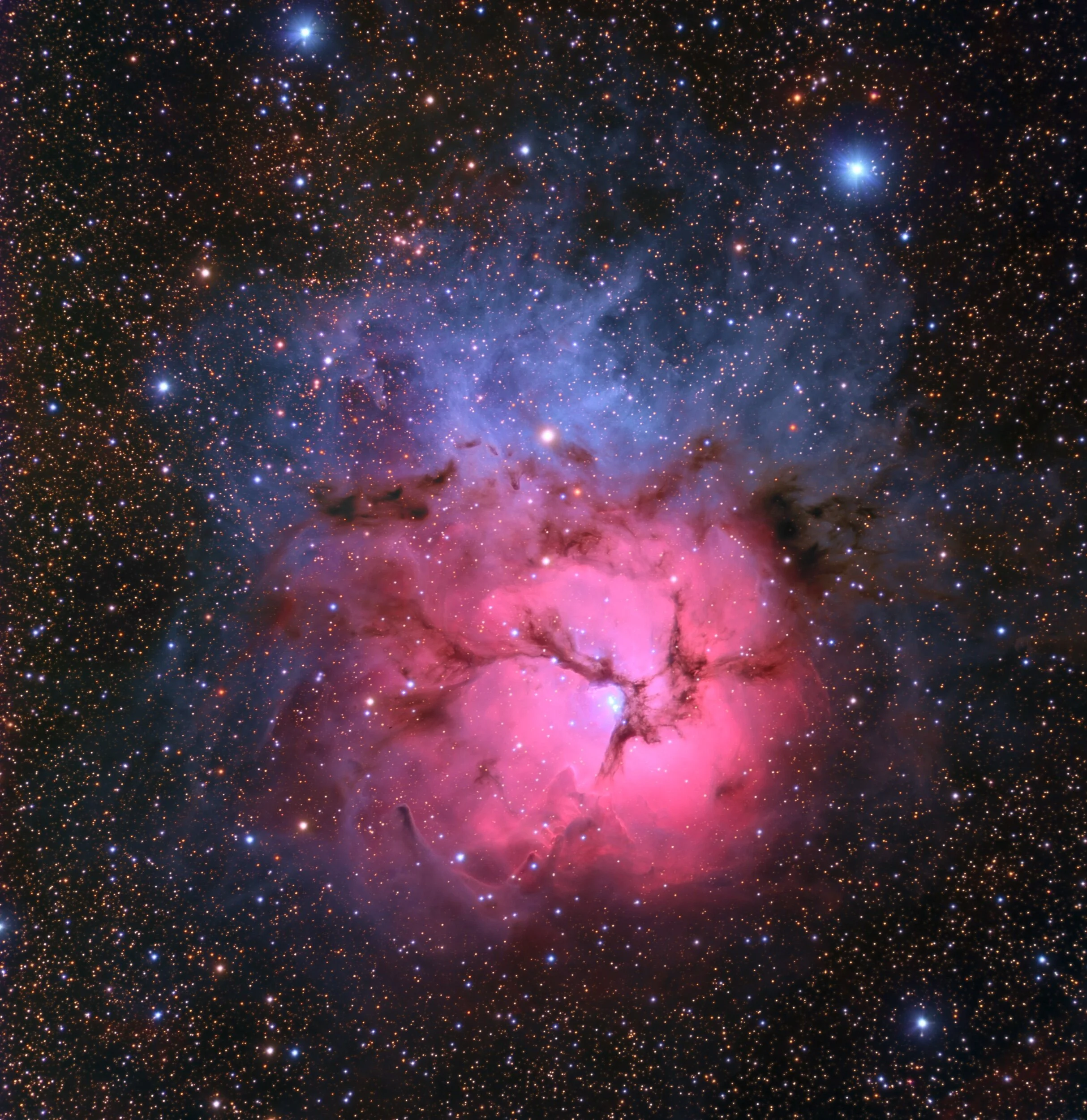
AAPOD2 Image Archives
Sort 2025 By Month: January | February | March | April | May | June | July | August | September | October | November | December
M20 - Trifid Nebula in SHO and RGB Blend
Messier 20 (M20) - The Trifid Nebula
Messier 20, also known as the Trifid Nebula, is a striking combination of an emission nebula, a reflection nebula, and a dark nebula located in the constellation Sagittarius. This beautiful celestial object gets its name "Trifid," meaning "divided into three lobes," due to the prominent dark lanes that split the nebula into three distinct parts. At an estimated distance of 5,200 light-years from Earth, the Trifid Nebula is a significant site of star formation, where new stars are being born out of the interstellar dust and gas.
The Trifid Nebula showcases a vivid interplay of colors with its reddish-pink regions of ionized hydrogen (H II regions) glowing from the emission nebula, and the blue regions being the reflection nebula where starlight is scattered by the surrounding dust. The dark lanes are formed by dense clouds of gas and dust that block the light from the brighter regions behind them. Capturing images of M20, especially in multiple wavelengths, reveals intricate details about the processes of star birth and the complex structure of the nebula.
M20
Close up of M20 the Trifid Nebula. Located 9000 light years away in Sagittarius Trifid is a star forming nebula. It is a very popular subject for astrophotographers. This image was taken with our RiDK 700 in LRGB Hydrogen Alpha and Oxygen III to provide a detailed close up of the Nebula and surrounding gas clouds.
Imaged at El Sauce, Obstech, Chile
Image Processing: Mike Selby
System Control Software: Voyager by Leo Orazi.
Copyright: Mike Selby
M20 - NGC 6514 - The Trifid Nebula
Image Description and Details :
This is my image of the wonderful and iconic Trifid Nebula. It is about 4100 ly away and is 42 ly across.My 0.54 degree x 0.54 degree field of view, beautifully accommodates it.Capture details:Dates; 2021-04-22 to 2021-05-18Lights: 24.5 hours integrationLum: 32 x 600 secsRed: 23 x 600 secsGreen: 22 x 600 secsBlue: 22 x 600 secsBias: 35Darks: 35Flats: 20 per colour channel per camera changeThere are some very bright foreground stars, which I decided not to reduce too much through Morphological Transformation, as compositionally I feel they add a lot to the image. My image scale and advantageous latitude, which means the object was at a good altitude throughout the imaging runs, plus generally decent seeing meant that good resolution of detail was possible. I was particularly pleased to resolve the stellar jet as imaged by the HST. This is a Herbog-Haro object numbered HH 399.
Copyright: Niall MacNeill
The Trifid Nebula in Sagittarius
The complex cloud displays an unusual combination of both red emission and blue reflection areas as well as numerous intricate dark patterns. The nebula is located 9000 light years away in the direction towards the galactic centre. The entire area is sprinkled with thousands of stars and fainter dusty and nebulous areas throughout. A separate prominent dark cloud appears dramatically silhouetted against the starry background to the right.A curious example of gas evaporation can bee seen near the core of the Trifid itself. Here a dense stalk, 8 light years from the centre, is emerging from the edge of the bubble surrounding the central cluster, and in the other direction a powerful stellar jet from a young star, HH 399 embedded in the gas, is shooting out in an upwards direction. The bright young stars in the central cluster emit strong radiation which eats away the surrounding gas and dust. The stalk only appears because a denser region lies at its very tip and protects a thin strip of the cloud from this interstellar erosion. The Hubble Space Telescope has imaged this fascinating area in high resolution: http://imgsrc.hubblesite.org/.../hs-2004-17-a-print.jpg. Throughout the nebula lies countless young T Tauri stars just having emerged from their birthplaces inside the gas and dust. These are typically rather faint and reddish, though they are more easily visible in this image of another stellar nursery near AntaresImage details: Date: May - September 2020Exposure: HaLRGB: 270:916:190:190:195 mins, total 29 hours 21 mins @ -25CTelescope: Homebuilt 12.5" f/4 Serrurier Truss NewtonianCamera: QSI 683wsg with Lodestar guiderFilters: Astrodon LRGB E-Series Gen 2 and 3nm H-AlphaTaken from my observatory in Auckland, New Zealand See Less
Copyright: Rolf Wahl Olsen
M20 - Nebulosa Trifida
Image Description and Details : M20 - Nebulosa Trifida
The subject of the image is a diffuse nebula in the constellation of Sagittarius, indeed it is possible to see the milky way and Halpha filaments in the background. Frames are acquired from the countryside of Sant'Antioco, Sardinia, Italy.






